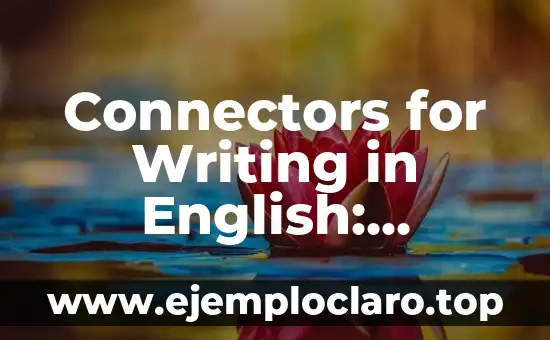Introducción a Conectores para la Redacción en Inglés
When it comes to writing in English, one of the most crucial aspects of producing a well-structured and cohesive essay is the effective use of connectors. Also known as linking words or transitional phrases, connectors are essential in linking ideas, sentences, and paragraphs together to create a logical flow of thought. In this article, we will delve into the world of connectors, exploring their types, functions, and importance in writing.
What are Connectors in Writing?
Connectors are words or phrases that connect ideas, sentences, or paragraphs together, creating a cohesive and logical flow of thought. They help to establish relationships between different parts of a text, making it easier for readers to follow the writer’s argument or narrative. Connectors can be classified into several categories, including additive, adversative, causal, temporal, and sequential connectors.
Types of Connectors in Writing
There are several types of connectors, each serving a specific purpose in linking ideas together. Some of the most common types of connectors include:
- Additive connectors (e.g., additionally, furthermore, moreover)
- Adversative connectors (e.g., however, on the other hand, nevertheless)
- Causal connectors (e.g., therefore, thus, consequently)
- Temporal connectors (e.g., meanwhile, subsequently, meanwhile)
- Sequential connectors (e.g., first, second, finally)
How to Use Connectors Effectively in Writing
Using connectors effectively requires a good understanding of their functions and how to integrate them seamlessly into your writing. Here are some tips to help you use connectors effectively:
- Use connectors to link ideas between sentences and paragraphs
- Choose the right connector to convey the intended relationship between ideas
- Use connectors sparingly to avoid repetition and monotony
- Vary your connector usage to add diversity to your writing
Importance of Connectors in Writing
Connectors play a vital role in writing, as they help to create a clear and logical flow of thought. Without connectors, a text can appear disjointed and confusing, making it difficult for readers to follow the writer’s argument or narrative. Effective use of connectors can:
- Improve the clarity and coherence of your writing
- Enhance the logical flow of your argument or narrative
- Increase the readability and engagement of your text
Common Mistakes to Avoid When Using Connectors
While connectors are essential in writing, there are common mistakes to avoid when using them. Some of these mistakes include:
- Overusing connectors, which can lead to repetition and monotony
- Misusing connectors, which can create confusion and ambiguity
- Failing to use connectors consistently, which can disrupt the flow of thought
How to Choose the Right Connector for Your Writing
Choosing the right connector for your writing requires a good understanding of their functions and how they can be used to convey different relationships between ideas. Here are some tips to help you choose the right connector:
- Consider the relationship between ideas and choose a connector that conveys that relationship
- Use a thesaurus or dictionary to find alternative connectors to add variety to your writing
- Read and analyze the writing of others to learn how they use connectors effectively
Can Connectors Help with Coherence and Cohesion?
Yes, connectors can help with coherence and cohesion in writing. By using connectors, writers can create a clear and logical flow of thought, making it easier for readers to follow their argument or narrative. Connectors can help to:
- Establish relationships between ideas and create a logical flow of thought
- Create a sense of continuity and coherence in your writing
- Enhance the overall cohesion of your text
How Do Connectors Differ from Transitional Phrases?
Connectors and transitional phrases are often used interchangeably, but they serve slightly different purposes in writing. While connectors link ideas together, transitional phrases help to signal a shift or transition in the text. Here’s how to distinguish between the two:
- Connectors link ideas together, while transitional phrases signal a shift in the text
- Connectors are often used to create a logical flow of thought, while transitional phrases are used to create a sense of continuity
What are Some Common Connectors in English?
Here are some common connectors in English, grouped by category:
- Additive connectors: additionally, furthermore, moreover, in addition
- Adversative connectors: however, on the other hand, nevertheless, in contrast
- Causal connectors: therefore, thus, consequently, as a result
- Temporal connectors: meanwhile, subsequently, meanwhile, afterward
- Sequential connectors: first, second, finally, lastly
How Can Connectors Improve Your Writing Style?
Using connectors effectively can improve your writing style in several ways. Here are some benefits of using connectors:
- They can add variety and diversity to your writing
- They can help to create a clear and logical flow of thought
- They can enhance the coherence and cohesion of your text
- They can make your writing more engaging and readable
Can Connectors Be Used in Different Writing Styles?
Yes, connectors can be used in different writing styles, including academic, creative, and professional writing. Here’s how connectors can be adapted to different writing styles:
- Academic writing: Use formal and technical connectors to create a clear and logical flow of thought
- Creative writing: Use creative and descriptive connectors to add flavor and tone to your writing
- Professional writing: Use concise and clear connectors to convey complex information effectively
What are Some Common Errors in Using Connectors?
Here are some common errors to avoid when using connectors:
- Using the wrong connector for the context
- Overusing connectors, leading to repetition and monotony
- Misplacing connectors, which can disrupt the flow of thought
- Failing to use connectors consistently, which can create confusion
How Can You Practice Using Connectors Effectively?
Here are some tips to help you practice using connectors effectively:
- Read and analyze the writing of others to learn how they use connectors
- Practice using connectors in your own writing, starting with simple exercises
- Get feedback from others on your use of connectors and make adjustments accordingly
- Use online resources and writing guides to improve your connector usage
What are the Benefits of Mastering Connectors in Writing?
Mastering connectors in writing can have several benefits, including:
- Improved writing clarity and coherence
- Enhanced writing style and tone
- Increased readability and engagement
- Better communication of ideas and arguments
Can Connectors Help with Writing Fluency?
Yes, connectors can help with writing fluency by creating a clear and logical flow of thought. By using connectors effectively, writers can:
- Create a sense of continuity and cohesion in their writing
- Enhance the overall flow of their text
- Improve the readability and engagement of their writing
INDICE







